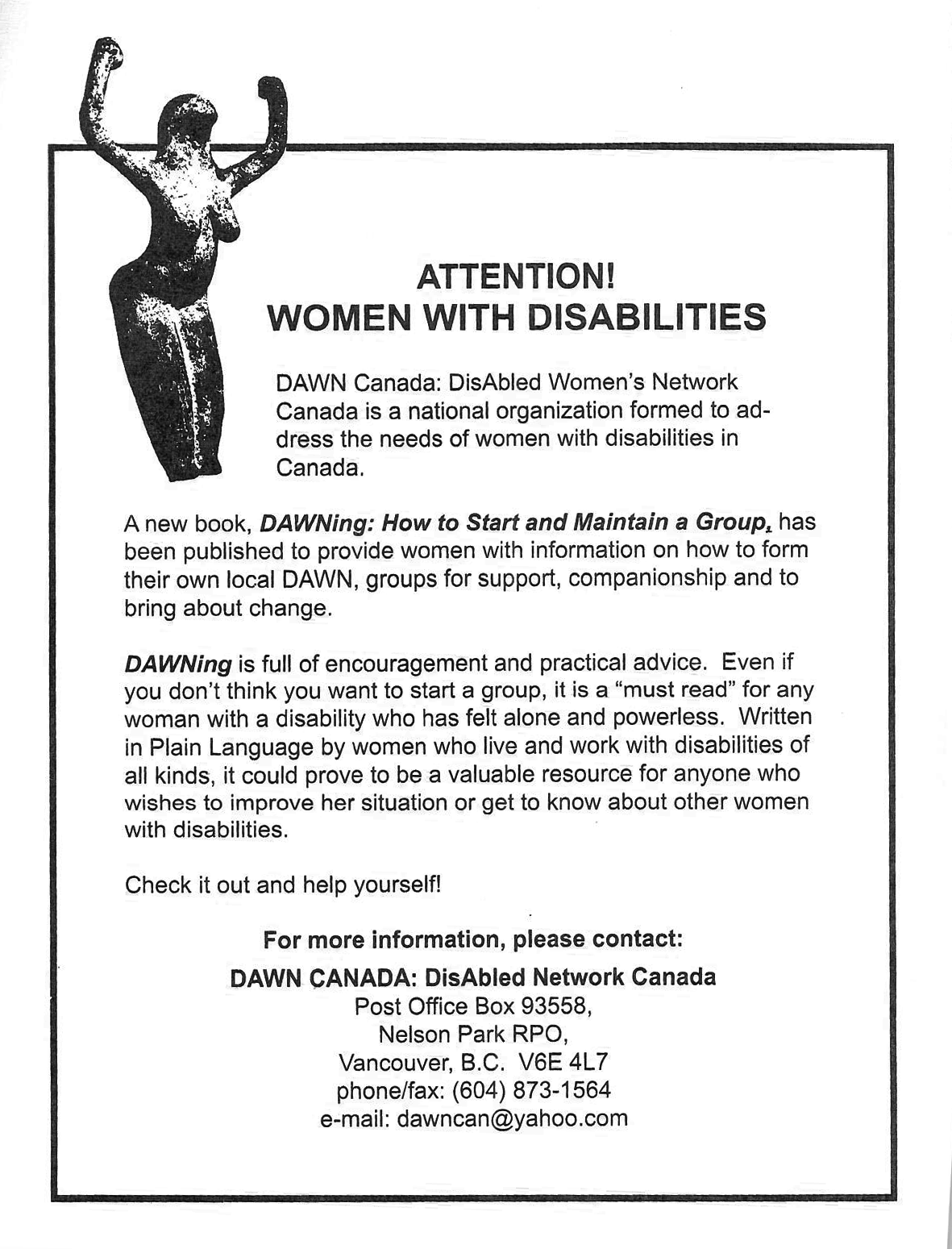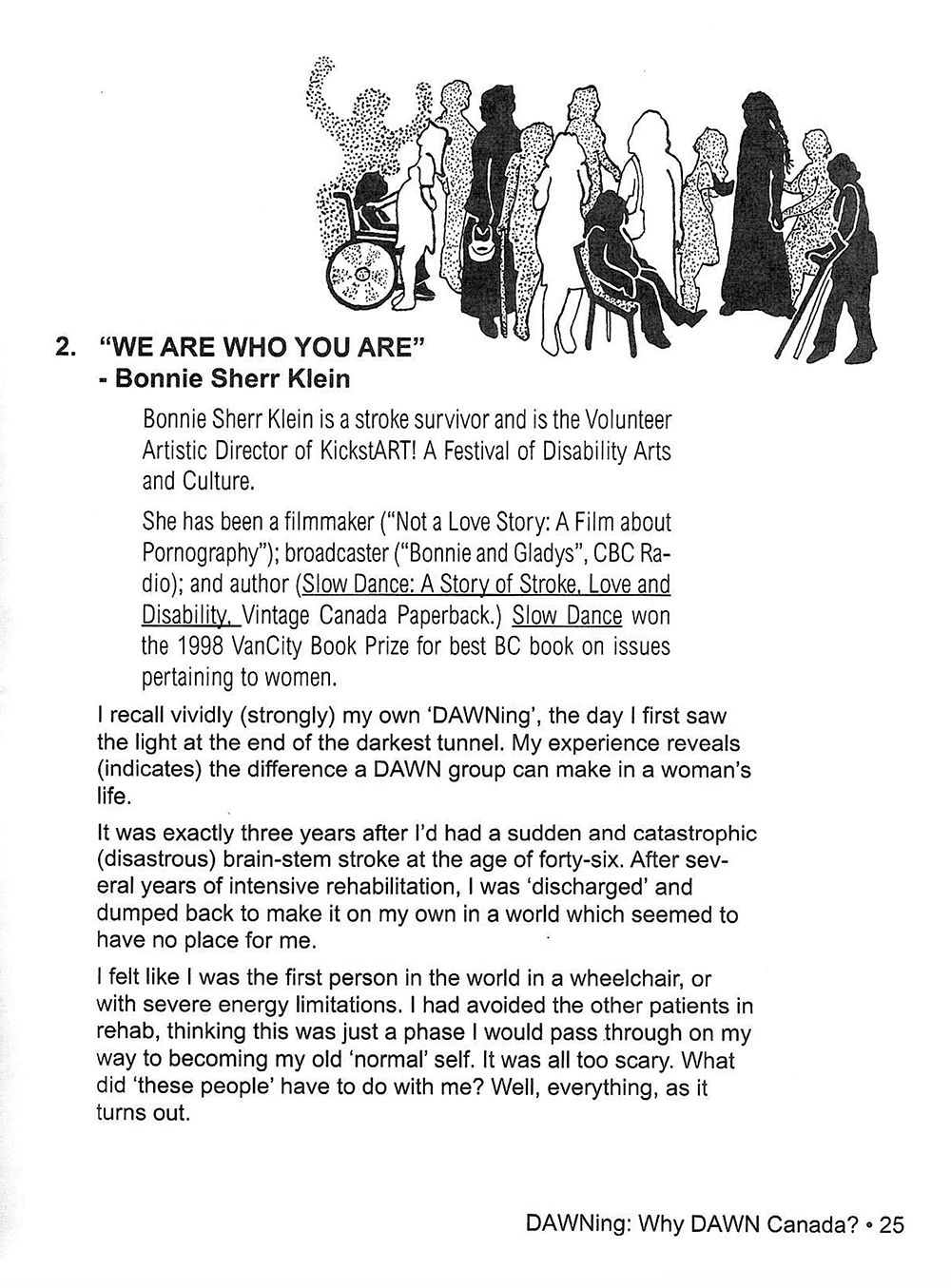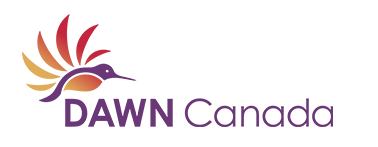HERstory: 1999 DAWNing, How to Start and Maintain a Group

Joan Meister, Shirley Masuda, Eileen O’Brien, Claudette Perron, Maria Barile, E.J. Miller-Towle, Sue Leon, Maxine Thomas, Margo Massie, Pam Horton, Barb Goode, Kathy Hawkins, Linda Brown, Bonnie Sherr Klein, Catherine Frazee, Yvonne Peters, Barbara Findlay, Lee Lakeman, Maxine Thomas, Nancy Riche, Judy Rebick, Mary Williams, Joan Westland, Lynda White.
These are just some of the women whose ideas, work, and passion touched a seminal publication from DAWN Canada’s history. DAWNing: How to Start and Maintain a Group was published in 1999 as a guide to starting local DAWN Canada chapters all over Canada. In a time before the ubiquity of the internet, this book was disseminated by asking readers to tear out, photocopy, and post a flyer included in the back of the publication. That flyer reads:
“A new book, DAWNing: How to Start and Maintain a Group, has been published to provide women with information on how to form their own local DAWN, groups for support, companionship and to bring about change.
DAWNing is full of encouragement and practical advice. Even if you don’t think you want to start a group, it is a ‘must read’ for any woman with a disability who has felt alone and powerless. Written in Plain Language by women who live and work with disabilities of all kinds, it could prove to be a valuable resource for anyone who wishes to improve her situation or get to know about other women with disabilities.”

The manual is over 200 pages long, with seven chapters outlining DAWN Canada’s early feminist practices, their cross-disability politics, and guidelines for building, maintaining, and growing a DAWN chapter. Each section was contributed by an individual woman, including a section called Electronic Communications by DAWN Canada’s current board president, Kathy Hawkins (who was interviewed for HERstory last month).
What is most clearly present in this publication, however, is the vulnerability, the power, and the heart of the contributing writers. For example, Bonnie Sherr Klein describes her own “dawning” as she survived a stroke at age forty-six and began her new life as a wheelchair user and a woman with limited energy. She describes the resistance she felt at first; a reluctance to see herself as disabled. She said she felt frightened and alone until she found DAWN. Klein writes:
“Three years after my stroke, when I was at my lowest point … I recalled hearing something in my previous life as a feminist filmmaker about a network of feminists with disabilities, something like DAWN Canada.
…
I was no longer alone. Here I was not Other because everyone was Other. Now that I knew other feminists with disabilities, I was finally ready to accept that I would be disabled for the rest of my life. DAWN was the turning point in my re-entry to life.”

This publication helped women from all walks of life come together and bond over their shared experience of disability. DAWNing fostered friendships, relationships, and the then burgeoning Disability Arts and Culture movement. In her chapter, The Dawning of Disability Culture, Catherine Frazee notes the importance of art in political movements. It is through art that language can be reclaimed, communities can be built, and political messages can be spread. Frazee writes:
“People with disabilities everywhere share the experience of being segregated, institutionalized, marginalized and silenced. We know that our very presence in mainstream society makes some people uncomfortable. Disability culture responds to all of this with one very loud and clear message: ‘Get over it!’ Artists and performers with disabilities make no apology. They are in your face. Not only are we visible and vocal, not only are we laughing and singing about our joy in life and love for ourselves and each other, but we are allowing ourselves to express the depths of our rage and our pain.”

The twenty years that followed the publication of DAWNing: How to Start and Maintain a Group saw DAWN Canada through many changes; most notably, changes of governance. This early DAWN publication shows us the hopefulness and wisdom of its authors. These women with disabilities saw strength in unification and set about sharing their ideas for grassroots, constituent-led governance at the local level.
Unfortunately, history has shown us again and again that when the onus of advocacy is solely on the shoulders of the oppressed, it is very difficult for any activist initiative to gain sustainability. Due to a lack of funding and a lack of support, DAWN Canada’s original governance structure (outlined in DAWNing) collapsed in the mid-2000s. While this was certainly a challenging moment in DAWN’s history, it proved to be a necessary turning point as well. Under the direction of National Executive Director Bonnie Brayton, the DisAbled Women’s Network of Canada has grown into a national not-for-profit organization that advocates for the rights of all Deaf and disabled women, girls, and gender minorities across Canada. Now, as we celebrate our 35th year and we continue to advocate at an increasingly international level, that evolution continues.
Since the launch of DAWNing, our scope has widened and our mandate has focused but our roots remain firmly planted. Looking back on this publication, it is clear that the heart, soul, and politics of DAWN Canada were written in these pages.
HERstory is a retrospective on DAWN Canada’s feminist disability activism
In 1985, seventeen women from across Canada met to discuss disability rights issues from women's perspectives. From that meeting, DAWN Canada was founded. In the 35 years that followed, DAWN Canada engaged in activist work that later became the foundation for our four-pillar approach: research, education, policy, and advocacy. To mark our 35th year in service and in hope, we will be highlighting six moments in DAWN Canada’s history including publications from our archives, landmark Supreme Court cases in which we participated, and other pieces of our story. We will also be interviewing six women connected to DAWN Canada's history and sharing their stories and reflections. Click here to read all the posts in the HERstory project.
